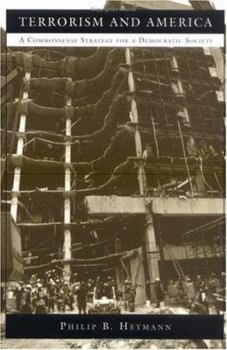Terrorism and America: A Commonsense Strategy for a Democratic Society
(Part of the Belfer Center Studies in International Security Series)
Select Format
Select Condition 
Book Overview
The bombings of the World Trade Center and the Oaklahoma City federal building have shown that terrorist attacks can happen anywhere in the United States. Around the globe, massacres, hijackings, and... This description may be from another edition of this product.
Format:Paperback
Language:English
ISBN:0262581973
ISBN13:9780262581974
Release Date:August 2000
Publisher:MIT Press
Length:215 Pages
Weight:0.80 lbs.
Dimensions:0.5" x 6.0" x 9.0"
Age Range:18 years and up
Grade Range:Postsecondary and higher
Customer Reviews
1 rating
An excellent introductory text on this subject.
Published by Thriftbooks.com User , 23 years ago
Phillip Heymann offers a clear-minded, if somewhat cursory, appraisal of the difficulties terrorist activity presents democratic and "open" societies. He manages in just a little over 150 pages to clearly identify the dangers over-reaction to either terrorist threats or actions can pose to a society, as well the risks posed when a terrorist incident involves more than one country, without burdening the reader with too much detail. This is not, however, an intellectual treatise or theoretical work. Heymann very clearly illustrates his points by examining specific incidents and their consequences involving not merely the US, but Italy, the UK, Germany, Israel, Columbia, and others. Perhaps most illustrative is his examination of the 1985 Achille Lauro hijacking, which drives home the complications arising when multiple governments and competing policies become involved, and Chapter 7 on the criminal just system, which touches on everything from the difficulties of investigation to witness intimidation to the use (and possible abuse) of deadly force to the issue of civil rights. By the end, Heymann delivers on his promise of a "common sense" strategy for dealing with both domestic and international terrorism. Pragmatically admitting the danger of terrorism can never be completely eliminated, it can at least be minimized by a combination of steps, including more targetted intelligence gathering, greater sharing of information with our allies, resisting giving into terrorist demands, and better training of law enforcement in dealing with terrorism.The book has two small failings however. First, it provides only a cursory examination of what terrorism itself involves. While he devotes an entire chapter to the phenomenon of political violence, Heymann gives only passing mention to the motives and actions that could be involved and almost no examinaiton of the differences between them. This leaves the reader with little appreciation of the differences, both in motive and method, between the decades of bombings committed by Basque Sepratists in Spain and the more sinister activities of the Aum Shinrikyo cult between 1994 and 1995. An in-depth analysis would have actually detracted from Heymann's intent, but a few pages on these distinctions wouldn't have hurt the text.Secondly, he concentrates almost exclusively on conventional forms of terrorism. He mentions the threats of nuclear, chemical, and biological (NBC) terrorism, but does so in context of conflicts between states, stating the prospect of NBC terrorism is "unlikely". While this is certainly true now, this may well change in coming years. And the specter of an incident like that of the Tokyo subway gassing done by Aum Shinrikyo in 1995 can significantly change a government's options in terms of response. This is actually a minor point given the number of excellent books on the subject already out there, but even a short examination of the dang




